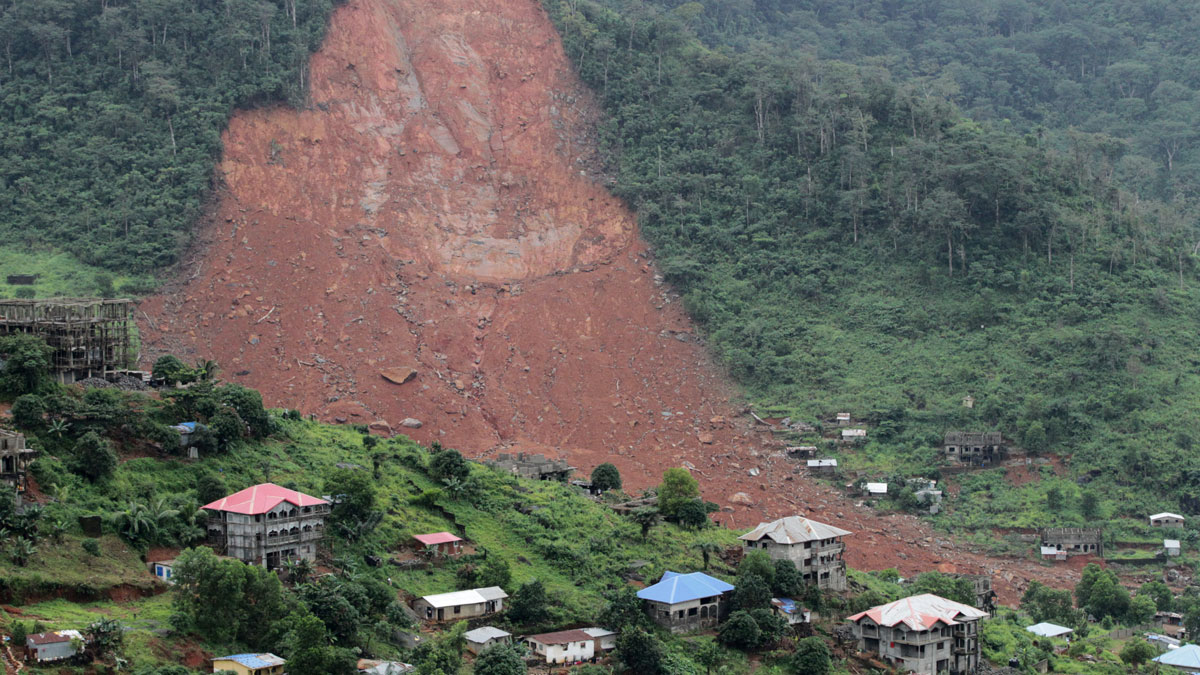Protecting A Swiss Mountain Village From Landslide Disaster

Table of Contents
Assessing the Risk of Landslide Disaster
Understanding the risk is the first crucial step in protecting a Swiss mountain village from a landslide disaster. This involves a comprehensive approach combining advanced technology and meticulous analysis.
Geological Surveys and Mapping
Detailed geological surveys are paramount for identifying unstable slopes and predicting potential landslide paths. Geotechnical engineering plays a vital role here, utilizing techniques like ground penetration radar to analyze subsurface conditions and assess slope stability. This data is crucial for creating accurate landslide hazard maps.
- Utilizing advanced mapping technology (LiDAR, GIS): Light Detection and Ranging (LiDAR) provides high-resolution topographic data, crucial for identifying subtle changes in slope angles that might indicate instability. Geographic Information Systems (GIS) then integrate this data with other relevant information, creating comprehensive risk assessments.
- Analyzing historical landslide data: Studying past landslide events helps identify patterns and predict future occurrences. This historical analysis informs risk assessment models, pinpointing high-risk zones.
- Identifying high-risk zones within the village: This precise identification allows for targeted mitigation efforts, focusing resources where they are most needed. Understanding specific vulnerable areas within the village allows for better land use planning and building code enforcement.
Monitoring Systems for Early Warning
Implementing sophisticated monitoring systems provides early warning signs of potential landslide activity. These systems are vital for giving residents sufficient time to evacuate, minimizing the impact of a landslide disaster.
- Installation of inclinometers and extensometers: These instruments measure ground deformation, providing critical data on slope movement. Early detection of even minute changes can alert authorities to potential problems.
- Real-time data acquisition and analysis: Continuous monitoring allows for immediate identification of changes, facilitating rapid response. Data is often transmitted wirelessly for real-time analysis and automated alerts.
- Development of automated alert systems for residents: These systems can provide timely warnings via text message, sirens, or other means, giving residents enough time to evacuate safely.
Implementing Mitigation Strategies for Landslide Disaster Prevention
Once the risks are assessed, implementing effective mitigation strategies is crucial to preventing a landslide disaster. This involves a combination of engineering solutions and careful land use planning.
Engineering Solutions for Slope Stabilization
Several engineering techniques can significantly stabilize slopes and minimize the risk of landslides. These solutions aim to reinforce unstable slopes and prevent the initiation of landslides.
- Construction of reinforced retaining walls: These walls provide support to unstable slopes, preventing material from sliding downhill. Careful design, considering the soil properties and expected loads, is vital.
- Implementation of drainage systems to reduce water infiltration: Water significantly weakens soil, increasing the risk of landslides. Drainage systems, such as subsurface drains and surface ditches, help divert water away from vulnerable areas.
- Bioengineering techniques (e.g., planting vegetation): Vegetation helps stabilize slopes by binding soil together and reducing erosion. Strategic planting of appropriate species can significantly enhance slope stability.
Land Use Planning and Zoning Regulations
Effective land use planning is critical in reducing landslide risk. This involves careful regulation of development in high-risk areas and promoting sustainable land management practices.
- Restricting development in high-risk areas: Prohibiting construction in known high-risk zones minimizes the potential impact of future landslides. This might involve re-zoning vulnerable land to non-residential uses.
- Implementing building codes that address landslide risks: Stricter building codes can ensure that new constructions are designed and built to withstand potential landslide forces.
- Promoting sustainable land management practices: Careful management of forests and other vegetation helps prevent erosion and maintain slope stability. Sustainable practices minimize environmental disturbance and reduce landslide risk.
Community Engagement and Preparedness for Landslide Disaster
Even with the best mitigation strategies, community engagement and preparedness are essential for minimizing the impact of a landslide disaster.
Public Awareness Campaigns and Education
Educating the community about landslide risks and preparedness is paramount. This includes regular communication and comprehensive training to equip residents with the knowledge to act effectively.
- Workshops and seminars on landslide safety: Providing regular training sessions familiarizes residents with the warning signs, evacuation procedures, and emergency response measures.
- Distribution of informational brochures and pamphlets: Easy-to-understand materials provide essential information about landslide risks and safety precautions. These should be regularly updated with the latest information and procedures.
- Development of a community emergency response plan: A well-defined plan outlines roles, responsibilities, and communication protocols during an emergency, ensuring a coordinated response.
Evacuation Procedures and Emergency Response
Clear and well-rehearsed evacuation procedures and emergency response plans are crucial. This includes establishing clear communication channels and practicing emergency response drills.
- Clearly marked evacuation routes: Well-signed and easily accessible routes ensure safe and efficient evacuation during an emergency.
- Designated assembly points for evacuees: Pre-designated assembly points allow for easy accountability and coordination of rescue efforts.
- Regular drills and training exercises: Regular drills ensure that residents and emergency personnel are well-prepared to respond effectively to a landslide.
Conclusion
Protecting our beautiful Swiss mountain villages from landslide disaster requires a multifaceted approach. By integrating geological assessment, implementing robust mitigation techniques, and fostering a culture of community preparedness, we can create safer and more resilient communities. The combination of advanced technology, engineering solutions, and community engagement proves vital in reducing the risk and minimizing the impact of this potentially devastating natural hazard. Learn more about landslide disaster prevention and get involved in protecting these precious mountain communities today! Find out more about landslide mitigation efforts and support local initiatives working to enhance the safety of Swiss Alps villages.

Featured Posts
-
 Dont Miss Out Movies Leaving Hulu In Month Year
May 23, 2025
Dont Miss Out Movies Leaving Hulu In Month Year
May 23, 2025 -
 Freddie Flintoffs Recovery From Crash To New Role Addressing Ptsd And Facial Injuries
May 23, 2025
Freddie Flintoffs Recovery From Crash To New Role Addressing Ptsd And Facial Injuries
May 23, 2025 -
 Poraka Od Ronaldo Do Kho Lund Po Imitatsi Ata Na Negovoto Slav E
May 23, 2025
Poraka Od Ronaldo Do Kho Lund Po Imitatsi Ata Na Negovoto Slav E
May 23, 2025 -
 Freddie Flintoff Confirms Disney Documentary About His Crash
May 23, 2025
Freddie Flintoff Confirms Disney Documentary About His Crash
May 23, 2025 -
 Big Rig Rock Report 3 12 Key Takeaways From Rock 101
May 23, 2025
Big Rig Rock Report 3 12 Key Takeaways From Rock 101
May 23, 2025
Latest Posts
-
 Rio Tinto And Andrew Forrest Disagree On Pilbaras Environmental State
May 23, 2025
Rio Tinto And Andrew Forrest Disagree On Pilbaras Environmental State
May 23, 2025 -
 The Pilbara Debate Rio Tintos Defence Against Wasteland Accusations
May 23, 2025
The Pilbara Debate Rio Tintos Defence Against Wasteland Accusations
May 23, 2025 -
 Rio Tinto Addresses Environmental Concerns Raised By Andrew Forrest Regarding The Pilbara
May 23, 2025
Rio Tinto Addresses Environmental Concerns Raised By Andrew Forrest Regarding The Pilbara
May 23, 2025 -
 Pilbaras Future Rio Tintos Response To Andrew Forrests Criticism
May 23, 2025
Pilbaras Future Rio Tintos Response To Andrew Forrests Criticism
May 23, 2025 -
 The 3 Billion Question Sses Spending Cuts And Future Outlook
May 23, 2025
The 3 Billion Question Sses Spending Cuts And Future Outlook
May 23, 2025
